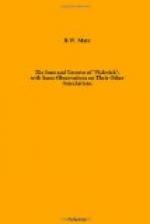Another distinguished writer, the American novelist and artist, F. Hopkinson Smith, in his book, Dickens’s London, fell into a similar blunder. Indeed, his book contains some glaring mistakes, owing, no doubt, to the fact, which he admits, that he gathered his information from any Tom, Dick or Harry he came in contact with during his wanderings. In describing his visit to the “George,” he found incidents from Pickwick to fit every nook and cranny in the building and quoted them with much conviction. But he quoted no facts, nor did he give any data to substantiate his statements. Someone told him it was the original of the “White Hart,” as they told him that the house named Dickens House in Lant Street was where Dickens once lived, irrespective of the fact that the actual house was demolished years before. Yet that satisfied him, he took no trouble to make further enquiries and then imagined the rest. In regard to the “George” he let his imagination run riot, dilated on this being Miss Wardle’s room, this being the room where the couple were discovered, and further states that Dickens made the inn a favourite one of his when a boy in Lant Street, and speaks of the seat he used to sit in. All of which is sheer nonsense.
Dickens may have known the George Inn in those early days, but being only a mere boy is not likely to have frequented it. Although in later years—those of Little Dorrit and the Uncommercial Traveller—it is quite likely he may have visited it. Indeed, Miss Murray, the present hostess, tells us he did. Her authority was Abraham Dawson, a well-known carman and carrier in days gone by, who was a nephew of W. S. Scholefield who owned the inn at the time. Dawson assured her that he frequently chatted with Dickens in the coffee-room.
Yet the only occasion, so far as we are aware, that the novelist actually mentions the inn is in Little Dorrit, Book I, Chapter XXII, where Maggy, speaking of Tip, says: “If he goes into the ‘George’ and writes a letter. . . .”
No, the George Inn is just a fine survival of old days—the old days of which Dickens wrote—and is similar, in many respects, to what the ‘White Hart’ used to be. As such Dickensians have a great affection for it, and there is no need to invent stories about it to justify their reverence.
Mr. A. St. John Adcock is another writer who steers clear of the confusion. In The Booklover’s London, after referring to the “White Hart,” he goes on to say: “If you step aside up George Yard, which is next to the ‘White Hart’ yard, you may see the old George Inn which, with its low ceilings, ancient rafters and old wooden galleries outside, closely resembles what the ‘White Hart’ used to be, and gives us an idea of the inn yards in which the strolling players of Shakespeare’s time used to set up their stages.”
Let us leave it at that and retain our regard for the old inn for what it is, rather than for what it is not.




